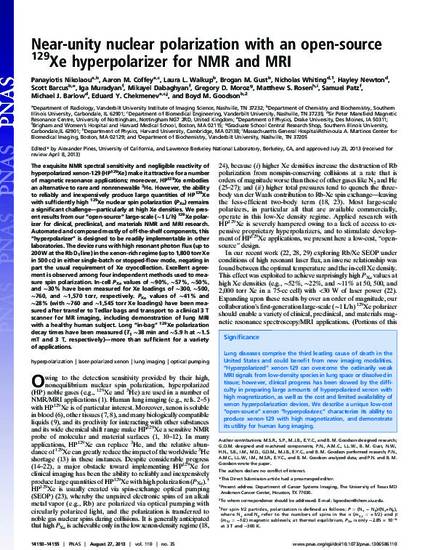
Article
Near-unity nuclear polarization with an open-source 129Xe hyperpolarizer for NMR and MRI
Proceedings of the National Academy of Sciences of the United States of America
(2013)
Abstract
The exquisite NMR spectral sensitivity and negligible reactivity of hyperpolarized xenon-129 (HP129Xe) make it attractive for a number of magnetic resonance applications; moreover, HP129Xe embodies an alternative to rare and nonrenewable 3He. However, the ability to reliably and inexpensively produce large quantities of HP129Xe with sufficiently high 129Xe nuclear spin polarization (PXe) remains a significant challenge—particularly at high Xe densities. We present results from our “open-source” large-scale (∼1 L/h) 129Xe polarizer for clinical, preclinical, and materials NMR and MRI research. Automated and composed mostly of off-the-shelf components, this “hyperpolarizer” is designed to be readily implementable in other laboratories. The device runs with high resonant photon flux (up to 200 W at the Rb D1 line) in the xenon-rich regime (up to 1,800 torr Xe in 500 cc) in either single-batch or stopped-flow mode, negating in part the usual requirement of Xe cryocollection. Excellent agreement is observed among four independent methods used to measure spin polarization. In-cell PXe values of ∼90%, ∼57%, ∼50%, and ∼30% have been measured for Xe loadings of ∼300, ∼500, ∼760, and ∼1,570 torr, respectively. PXe values of ∼41% and ∼28% (with ∼760 and ∼1,545 torr Xe loadings) have been measured after transfer to Tedlar bags and transport to a clinical 3 T scanner for MR imaging, including demonstration of lung MRI with a healthy human subject. Long “in-bag” 129Xe polarization decay times have been measured (T1 ∼38 min and ∼5.9 h at ∼1.5 mT and 3 T, respectively)—more than sufficient for a variety of applications.
Keywords
- hyperpolarization,
- laser-polarized xenon,
- lung imaging,
- optical pumping
Disciplines
Publication Date
August 27, 2013
DOI
10.1073/pnas.1306586110
Citation Information
Panayiotis Nikolaou, Aaron M. Coffey, Laura L. Walkup, Brogan M. Gust, et al.. "Near-unity nuclear polarization with an open-source 129Xe hyperpolarizer for NMR and MRI" Proceedings of the National Academy of Sciences of the United States of America Vol. 110 Iss. 35 (2013) p. 14150 - 14155 Available at: http://works.bepress.com/nicholas-whiting/1/
